Plaquettes en carbure cémentéégalement connues sous le nom de plaquettes en carbure de tungstène, sont un élément essentiel dans le monde du travail des métaux et de l'usinage. Elles sont indispensables pour leur durabilité, leur efficacité et leur polyvalence. Si vous vous lancez dans le monde de l'usinage ou si vous cherchez simplement à améliorer votre arsenal d'outils, ce guide vous expliquera tout ce que vous devez savoir sur les plaquettes en carbure cémenté. De leurs types et applications aux propriétés des matériaux et à la sélection de la bonne plaquette, commençons.
Aperçu des plaquettes en carbure cémenté
Les plaquettes en carbure cémenté sont des outils de coupe largement utilisés dans la fabrication et le travail des métaux. Elles sont constituées d'un matériau composite composé de particules de carbure liées entre elles par un liant métallique. Cette composition unique leur confère une dureté supérieure, une résistance à l'usure et une capacité à supporter des températures élevées, ce qui en fait des outils idéaux pour couper, percer et façonner les matériaux métalliques.
Pourquoi le carbure cémenté ?
- Durabilité : Les plaquettes en carbure cémenté sont incroyablement durables et peuvent résister à un usage intensif.
- Efficacité : Ils conservent leur tranchant et leur efficacité de coupe sur de longues périodes.
- Polyvalence : Convient à une large gamme de matériaux et d'opérations d'usinage.
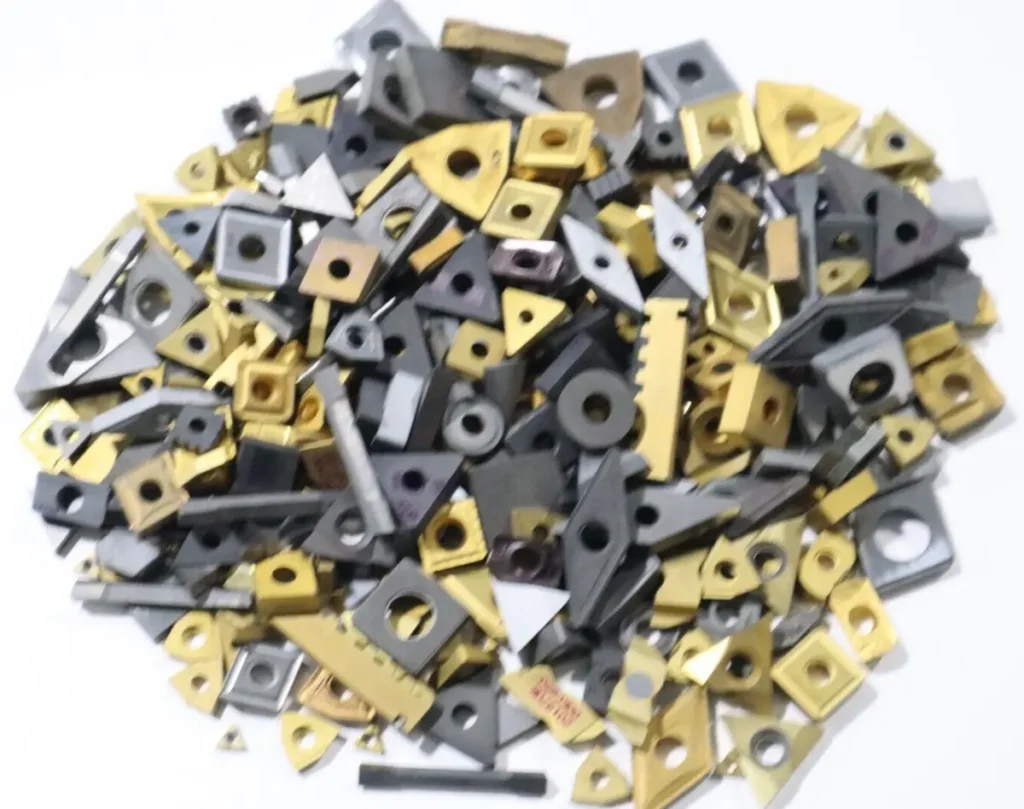
Types de Plaquettes en carbure cémenté
Il existe différents types de plaquettes en carbure cémenté conçues pour des applications spécifiques. Voici un aperçu des types les plus courants :
| Type d'insertion | Description |
|---|---|
| CNMG | Plaquette à usage général avec une arête de coupe de 80°, adaptée à l'ébauche et à la finition. |
| DNMG | Plaquette à 55°, idéale pour les opérations de finition. |
| TNMG | Plaquette triangulaire, polyvalente pour l'ébauche et la finition. |
| WNMG | Forme trigonale avec tranchant à 80°, utilisée pour l'ébauche et les coupes interrompues. |
| SNMG | Insert carré, très solide, utilisé pour les opérations lourdes. |
| CCMT | Plaquette à une face avec une arête de coupe de 80°, utilisée pour les applications de tournage. |
| VBMT | Insert en forme de diamant, utilisé pour les finitions fines. |
| RCMT | Plaquette ronde, idéale pour le profilage et le contournement. |
| APKT | Plaquette rectangulaire, utilisée pour les applications de fraisage. |
| RPGN | Plaquette ronde, idéale pour le profilage des matériaux souples. |
Applications des plaquettes en carbure cémenté
Les plaquettes en carbure cémenté sont utilisées dans une grande variété d'opérations d'usinage. Voici un aperçu de leurs applications :
| Application | Types d'insertion | Détails |
|---|---|---|
| Tournage | CNMG, DNMG, CCMT, VBMT | Les opérations de tournage impliquent la rotation de la pièce à usiner tandis qu'un outil de coupe stationnaire enlève de la matière. |
| Fraisage | APKT, RPGN | Le fraisage utilise un outil de coupe rotatif pour enlever de la matière d'une pièce dans différentes directions. |
| Forage | WNMG, SNMG | Les opérations de perçage permettent de créer des trous ronds dans une pièce à l'aide d'un foret rotatif. |
| Ennuyeux | CNMG, VBMT | L'alésage permet d'agrandir les trous existants afin d'obtenir une plus grande précision. |
| Profilage | RCMT, RPGN | Les opérations de profilage permettent de créer des contours et des formes complexes sur une pièce. |
| Filetage | TNMG, VBMT | Les plaquettes de filetage sont utilisées pour découper des filets de vis dans une pièce à usiner. |
| Rainurage | SNMG, CCMT | Le rainurage consiste à découper des canaux étroits dans une pièce. |
| Séparation | SNMG, WNMG | Les opérations de tronçonnage consistent à couper une partie d'une pièce. |
| Fraisage de face | APKT, CCMT | Le surfaçage utilise une fraise pour enlever de la matière de la surface d'une pièce afin de créer une surface plane. |
| Coupe interrompue | WNMG, SNMG | Les plaquettes conçues pour la coupe interrompue peuvent résister aux chocs et aux impacts des coupes irrégulières. |
Propriétés matérielles des Plaquettes en carbure cémenté
Il est essentiel de comprendre les propriétés des matériaux des plaquettes en carbure cémenté pour choisir celle qui convient le mieux à votre application.
| Propriété | Description |
|---|---|
| Dureté | Les plaquettes en carbure cémenté sont extrêmement dures et mesurent généralement de 8,5 à 9 sur l'échelle de Mohs. |
| Résistance à l'usure | Haute résistance à l'usure, ce qui les rend idéales pour les applications de coupe et d'abrasion. |
| Solidité | Malgré leur dureté, ils sont suffisamment résistants pour supporter les impacts et les chocs. |
| Résistance à la chaleur | Capable de conserver sa dureté et ses performances à des températures élevées, souvent supérieures à 1000°C. |
| Résistance à la corrosion | Résistants à la corrosion, ils prolongent leur durée de vie dans divers environnements. |
| Conductivité thermique | Une bonne conductivité thermique favorise la dissipation de la chaleur pendant les opérations de coupe. |
| Densité | Densité élevée, généralement entre 14,5 et 15,0 g/cm³. |

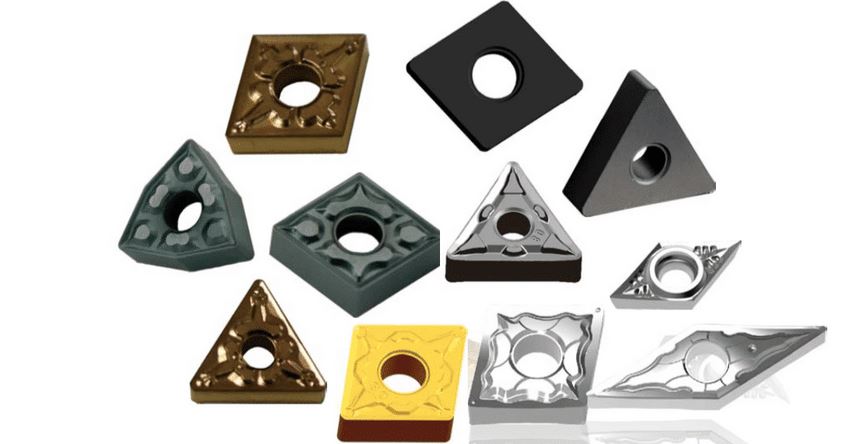
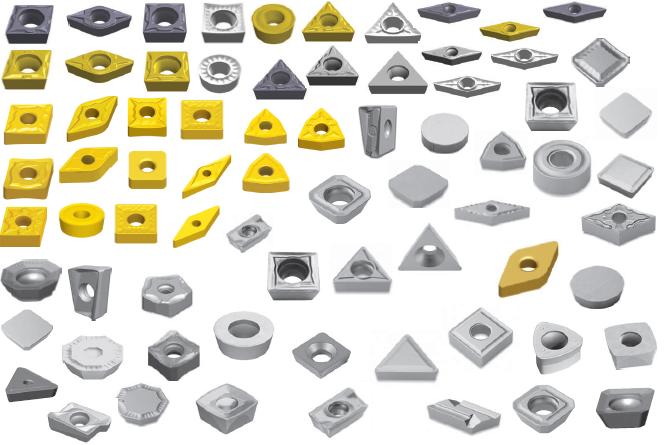

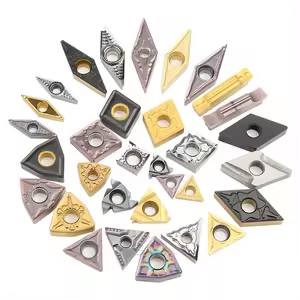
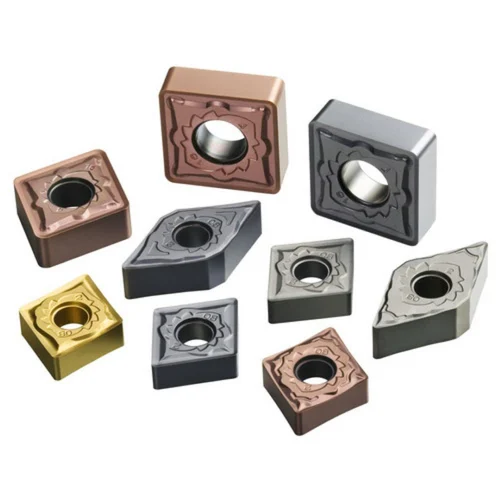
Composition et caractéristiques
La composition des plaquettes en carbure cémenté influe sur leurs propriétés et leurs performances.
| Composant | Description |
|---|---|
| Carbure de tungstène | Composant principal, assure la dureté et la résistance à l'usure. |
| Cobalt | Agit comme un liant, apportant ténacité et résistance aux chocs. |
| Carbure de titane | Améliore la dureté et la résistance thermique, en particulier dans les applications de coupe à grande vitesse. |
| Carbure de tantale | Augmente la résistance à l'usure et à la déformation, en particulier à haute température. |
| Carbure de niobium | Améliore la structure du grain, la ténacité et la résistance aux chocs thermiques. |
Dureté, solidité et résistance à l'usure
Ces trois propriétés sont cruciales pour déterminer l'adéquation d'une plaquette en carbure cémenté à une application spécifique.
| Propriété | Description |
|---|---|
| Dureté | Mesurée à l'aide des échelles Rockwell ou Vickers, elle indique la résistance du matériau à la déformation. |
| La force | Indique la capacité du matériau à résister aux contraintes mécaniques sans se rompre ou se déformer. |
| Résistance à l'usure | Se réfère à la capacité du matériau à résister à l'usure et à l'abrasion pendant les opérations de coupe. |
Spécifications, tailles, formes et normes
Les plaquettes en carbure cémenté sont disponibles en différentes tailles, formes et normes pour répondre aux différents besoins d'usinage.
| Spécifications | Détails |
|---|---|
| Normes ISO | ISO 1832 : Spécifie les dimensions et les tolérances des plaquettes en carbure. |
| Formes | Triangle, carré, losange, rond, rectangulaire, trigone, etc. |
| Tailles | Disponible en plusieurs tailles pour s'adapter à différents porte-outils et applications. |
| Notes | Les différentes qualités offrent des niveaux variables de dureté, de ténacité et de résistance à l'usure. |
Fournisseurs et détails des prix
Il est essentiel de trouver des fournisseurs fiables et de comprendre les prix pour pouvoir acheter en connaissance de cause.
| Fournisseur | Région | Gamme de produits | Prix (approx.) |
|---|---|---|---|
| Kennametal | Mondial | Large gamme de plaquettes en carbure | $5 - $50 par insert |
| Sandvik Coromant | Mondial | Inserts haute performance | $10 - $60 par insert |
| Matériaux Mitsubishi | Mondial | Différents types et qualités | $7 - $45 par insert |
| Sumitomo Electric | Mondial | Outils de coupe avancés | $8 - $55 par insert |
| ISCAR | Mondial | Plaquettes en carbure innovantes | $9 - $65 par insert |
| Outils Walter | Mondial | Gamme complète | $6 - $40 par insert |
| Outils Seco | Mondial | Inserts de haute précision | $7 - $50 par insert |
| YG-1 | Mondial | Des inserts de qualité à un prix abordable | $5 - $35 par insert |
| Tungaloy | Mondial | Inserts en matériaux avancés | $10 - $55 par insert |
| Kyocera | Mondial | Plaquettes à haute durabilité | $8 - $50 par insert |
Choisir le bon Plaquettes en carbure cémenté
Le choix de la plaquette en carbure cémenté appropriée implique la prise en compte de plusieurs facteurs.
| Considération | Détails |
|---|---|
| Matériau à usiner | Les propriétés des inserts varient selon les matériaux. |
| Type d'usinage | Le type d'opération (tournage, fraisage, perçage) dicte la forme de la plaquette et les propriétés requises. |
| Conditions de coupe | La vitesse, l'avance et la profondeur de coupe sont des facteurs cruciaux. |
| Compatibilité des porte-outils | S'assurer que l'insert est adapté au porte-outil utilisé. |
| Coût | Équilibre entre le coût et la performance pour répondre aux contraintes budgétaires. |
Avantages et limites
Comparer les avantages et les limites des plaquettes en carbure cémenté permet de prendre une décision en connaissance de cause.
| Aspect | Avantages | Limites |
|---|---|---|
| Dureté | Extrêmement dur, il conserve son tranchant pendant de longues périodes. | Peut être fragile et susceptible de s'écailler en cas d'utilisation inappropriée. |
| Résistance à l'usure | Haute résistance à l'usure, réduisant le besoin de remplacements fréquents. | Peut être plus cher que d'autres matériaux. |
| Résistance à la chaleur | Conserve ses propriétés à haute température, convient aux opérations à grande vitesse. | Un refroidissement et une lubrification précis sont nécessaires pour éviter les dommages thermiques. |
| Polyvalence | Convient à une large gamme de matériaux et d'applications. | Des inserts spécifiques sont nécessaires pour différentes applications, ce qui accroît la complexité de l'inventaire. |
| Durabilité | Longue durée de vie, réduction des temps d'arrêt et augmentation de la productivité. | Le coût initial élevé peut être une considération pour certains utilisateurs. |

FAQ
A quoi servent les plaquettes en carbure cémenté ?
Les plaquettes en carbure cémenté sont utilisées dans diverses opérations d'usinage telles que le tournage, le fraisage, le perçage et l'alésage. Elles sont préférées pour leur dureté, leur résistance à l'usure et leur capacité à maintenir leurs performances à des températures élevées.
Comment choisir la plaquette en carbure adaptée à mon application ?
Pour choisir la plaquette en carbure appropriée, il faut tenir compte du matériau à usiner, du type d'opération d'usinage, des conditions de coupe, de la compatibilité avec le porte-outil et du coût.
Quels sont les avantages des plaquettes en carbure cémenté ?
Les principaux avantages sont une dureté élevée, une excellente résistance à l'usure, une résistance à la chaleur, une polyvalence et une durabilité. Ces propriétés se traduisent par une augmentation de la productivité et de la durée de vie des outils.
Les plaquettes en carbure peuvent-elles être réutilisées ?
Oui, les plaquettes en carbure peuvent souvent être réutilisées après réaffûtage. Toutefois, l'étendue de la réutilisation dépend de l'état de la plaquette et des exigences spécifiques de l'usinage.
Quelles sont les qualités courantes des plaquettes en carbure cémenté ?
Les grades courants sont C2, C3, C5 et C7, chacun offrant différents niveaux de dureté, de ténacité et de résistance à l'usure adaptés à des applications spécifiques.
Comment dois-je stocker les plaquettes en carbure cémenté ?
Conservez-les dans un endroit frais et sec, à l'abri de la lumière directe du soleil et de l'humidité. L'utilisation de récipients de stockage appropriés peut aider à prévenir les dommages et à maintenir leur qualité.
Les plaquettes en carbure sont-elles soumises à des considérations environnementales ?
Les plaquettes en carbure cémenté sont fabriquées à partir de matériaux qui peuvent être recyclés. Il est important de suivre les bonnes pratiques de recyclage pour minimiser l'impact sur l'environnement.
Quelles sont les marques courantes de plaquettes en carbure cémenté ?
Parmi les marques les plus connues, citons Kennametal, Sandvik Coromant, Mitsubishi Materials, Sumitomo Electric, ISCAR, Walter Tools, Seco Tools, YG-1, Tungaloy et Kyocera.
Comment les plaquettes en carbure se comparent-elles aux autres outils de coupe ?
Par rapport à d'autres outils de coupe, les plaquettes en carbure offrent une dureté, une résistance à l'usure et une résistance à la chaleur supérieures. Elles sont plus durables et plus efficaces, mais leur coût initial peut être plus élevé.
Quelle est la durée de vie moyenne d'une plaquette en carbure ?
La durée de vie varie en fonction de l'application, du matériau usiné et des conditions de coupe. Toutefois, les plaquettes en carbure durent généralement plus longtemps que les autres outils de coupe en raison de leurs propriétés durables.
Conclusion
Les plaquettes en carbure cémenté sont une pierre angulaire de l'usinage moderne, offrant une durabilité, une efficacité et une polyvalence inégalées. Que vous soyez un professionnel chevronné ou que vous débutiez dans le monde de l'usinage, la compréhension des types, des applications, des propriétés des matériaux et des critères de sélection des plaquettes en carbure peut avoir un impact significatif sur votre productivité et votre réussite en matière d'usinage.
En choisissant la bonne plaquette en carbure, vous pouvez améliorer vos opérations d'usinage, réduire les temps d'arrêt et obtenir des résultats supérieurs. Explorez les différentes options, comprenez vos besoins spécifiques et prenez des décisions éclairées pour exploiter tout le potentiel des plaquettes en carbure cémenté dans vos projets.




